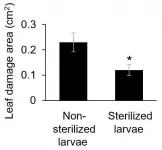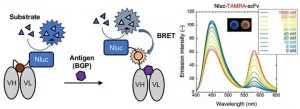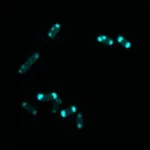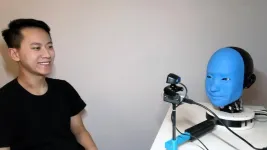(Press-News.org) Although insect larvae may seem harmless to humans, they can be extremely dangerous to the plant species that many of them feed on, and some of those plant species are important as agricultural crops. Although plants cannot simply flee from danger like animals typically would, many have nonetheless evolved ingenious strategies to defend themselves from herbivores. Herbivorous insect larvae will commonly use their mouths to smear various digestive proteins onto plants that they want to eat, and when plants detect chemicals commonly found in these oral secretions, they can respond to the injury by producing defensive molecules, including proteins and specialized metabolites, of their own that inactivate the insect's digestive proteins and thus prevent the insect from obtaining nutrients from the plant.
Of course, the existence of such chemical defense mechanisms in plants is a problem, which herbivorous insects must counter. One way that insects have evolved to overcome these problems is by forming partnerships with bacteria. For example, the digestive oral secretions of the Colorado potato beetle (Leptinotarsa decemlineata) include bacteria that can suppress the defense mechanisms of the tomato plants that the beetle commonly feeds on. The beetle and the bacteria have thus achieved "symbiosis," which is a term that biologists use to describe a mutually beneficial partnership: the beetle provides the bacteria with a comfortable environment inside its mouth and other secretory organs, and the bacteria help the beetle consume nutrients from tomato plants.
To Prof. Gen-ichiro Arimura of Tokyo University of Science, this is a fascinating result: "Although it is well known that symbiotic microorganisms in animals (especially bacteria in the intestines of herbivores such as pandas and cows) affect biological activities such as digestion and reproduction, the fact that they affect the prey (i.e., the plants) is not so well known." In other words, the fact that the insect's bacterial partners work to alter biochemical processes within the living plant before it is eaten is a matter of considerable interest to scientists.
Prof. Arimura and his research team, in collaboration with Okayama University, wondered whether such partnerships with bacteria may apply in the case of the insect Spodoptera litura, the larvae of which are major pests that commonly damage crops in Asia. In an article recently END
Partners in crime: Agricultural pest that relies on bacteria to overcome plant defenses
Scientists confirm that certain insect larvae host bacteria that help shut down plant defense mechanisms
2021-05-27
ELSE PRESS RELEASES FROM THIS DATE:
Engineered defects in crystalline material boosts electrical performance
2021-05-27
AMES, Iowa - Materials engineers don't like to see line defects in functional materials.
The structural flaws along a one-dimensional line of atoms generally degrades performance of electrical materials. So, as a research paper published today by the journal Science reports, these linear defects, or dislocations, "are usually avoided at all costs."
But sometimes, a team of researchers from Europe, Iowa State University and the U.S. Department of Energy's Ames Laboratory report in that paper, engineering those defects in some oxide crystals can actually increase electrical performance.
The research team - led by Jürgen Rödel and Jurij Koruza of the Technical University of Darmstadt in Germany - found certain defects produce significant improvements in two key measurements ...
Researchers develop technique to functionally identify and sequence soil bacteria one cell at a time
2021-05-27
Researchers from the Single-Cell Center at the Qingdao Institute of Bioenergy and Bioprocess Technology (QIBEBT) of the Chinese Academy of Sciences have developed a technique to sort and sequence the genome of bacteria in soil one bacterial cell at a time, while also identifying what its function is in the soil environment.
Their study was published in the journal mSystems on May 27.
Soil is home to a vast and complex microbiome, which features arguably the highest genomic diversity and widest heterogeneity of metabolic activities of cells on Earth. In turn, these metabolic activities can in principle provide the foundation for industrial production of numerous compounds of value.
The ability to pinpoint ...
Shedding new light: A new type of immunosensor for immunoassay tests
2021-05-27
Immunosensors are widely used in immunoassays to detect antigens. One such immunosensor is a quenchbody (Q-body), which contains a modified antibody fragment with a quenched fluorescent dye. When an antigen binds to the Q-body, the dye leaves the antibody and the fluorescence intensifies. The change in fluorescence intensity is easy to measure, making Q-body-based antigen detection systems incredibly simple. However, this method requires an external light source to excite the electrons in the fluorescent dye to produce luminescence.
One way to solve this is to induce luminescence by an alternative method. To achieve this, researchers ...
Climate skeptics not easily persuaded by available evidence, now or later
2021-05-27
EUGENE, ORE. -- May 27, 2021 -- Climate skeptics who aren't persuaded by the existing evidence from climate change are unlikely to change their minds for many years, according to a newly published quantitative study by a University of Oregon environmental economist
The central question posed by the study published in the journal Climate Change was "How much evidence would it take to convince skeptics that they are wrong?" The answer depended on the degree of skepticism. The study modeled two types of hypothetical skeptics -- those who were less extreme and believed the change in temperature was slight, as well as ...
Not fear, but goal importance and others' behavior makes you favour COVID-19 measures
2021-05-27
While earlier research has mostly looked into factors such as fear, perceived risk, age and political views to determine what makes individuals and societies more or less willing to drastically change their lifestyle and support government-imposed strict restrictions, in order to mitigate the spread of the COVID-19 pandemic, psychologists at the University of Zurich Charlotte Kukowski, Katharina Bernecker and Veronika Brandstätter took a different perspective.
Instead, they chose to find out the impact of people's perception of others' behaviour when it comes to the public good, as well as people's own self-control in sticking to behaviour guidelines. By using data from the United Kingdom and Switzerland, they concluded that, ...
Fight against antibiotic-resistant bacteria has a glowing new weapon
2021-05-27
AUSTIN, Texas -- In the perpetual arms races between bacteria and human-made antibiotics, there is a new tool to give human medicine the edge, in part by revealing bacterial weaknesses and potentially by leading to more targeted or new treatments for bacterial infections.
A research team led by scientists at The University of Texas at Austin has developed chemical probes to help identify an enzyme, produced by some types of E. coli and pneumococcal bacteria, known to break down several common types of antibiotics, making these bacteria dangerously resistant to treatment.
"In response to antibiotic ...
The robot smiled back
2021-05-27
New York, NY--May 27, 2021--While our facial expressions play a huge role in building trust, most robots still sport the blank and static visage of a professional poker player. With the increasing use of robots in locations where robots and humans need to work closely together, from nursing homes to warehouses and factories, the need for a more responsive, facially realistic robot is growing more urgent.
Long interested in the interactions between robots and humans, researchers in the Creative Machines Lab at Columbia Engineering have been working for five years to create EVA, a new autonomous robot with a soft and expressive ...
Archaeology: Prehistoric violence at Jebel Sahaba may not have been single event
2021-05-27
Reanalysis of the prehistoric cemetery Jebel Sahaba (Sudan), one of the earliest sites showing human warfare (13,400 years ago), suggests that hunter-fisher-gatherers engaged in repeated, smaller conflicts. The findings are published in Scientific Reports. Healed trauma on the skeletons found in the cemetery indicates that individuals fought and survived several violent assaults, rather than fighting in one fatal event as previously thought.
Isabelle Crevecoeur and colleagues reanalysed the skeletal remains of 61 individuals, who were originally ...
Icebergs push back
2021-05-27
Shortly before Jakobshavn Isbræ, a tidewater glacier in Greenland, calves massive chunks of ice into the ocean, there's a sudden change in the slushy collection of icebergs floating along the glacier's terminus, according to a new paper led by the Cooperative Institute for Research in Environmental Sciences (CIRES) at CU Boulder. The work, published in Nature Geoscience, shows that a relaxation in the thick aggregate of icebergs floating at the glacier-ocean boundary occurs up to an hour before calving events. This finding may help scientists better understand future sea-level rise scenarios and could also help ...
Jebel Sahaba: A succession of violence rather than a prehistoric war
2021-05-27
Since its discovery in the 1960s, the Jebel Sahaba cemetery (Nile Valley, Sudan), 13 millennia old, was considered to be one of the oldest testimonies to prehistoric warfare. However, scientists from the CNRS and the University of Toulouse - Jean Jaurès (1) have re-analysed the bones preserved in the British Museum (London) and re-evaluated their archaeological context. The results, published in Scientific Reports on May 27, 2021, show that it was not a single armed conflict but rather a succession of violent episodes, probably exacerbated by climate change.
Many individuals buried at Jebel Sahaba bear injuries, half ot them caused by projectiles, the points of which were found in the bones or the fill where the body was located. The ...
LAST 30 PRESS RELEASES:
New science reporting guide published for journalists in Bulgaria
New international study reveals major survival gaps among children with cancer
New science reporting guide published for journalists in Turkey
Scientists develop a smarter mRNA therapy that knows which cells to target
Neuroanatomy-informed brain–machine hybrid intelligence for robust acoustic target detection
Eight SwRI hydrogen projects funded by ENERGYWERX
The Lundquist Institute and its start-up company Vitalex Biosciences Announces Strategic Advancement of Second-Generation fungal Vaccine VXV-01 through Phase 1 Trials under $40 Million Competitive Con
Fine particles in pollution are associated with early signs of autoimmune disease
Review article | Towards a Global Ground-Based Earth Observatory (GGBEO): Leveraging existing systems and networks
Penn and UMich create world’s smallest programmable, autonomous robots
Cleveland researchers launch first major study to address ‘hidden performance killer’ in athletes
To connect across politics, try saying what you oppose
Modulating key interaction prevents virus from entering cells
Project explores barriers to NHS career progression facing international medical graduates
Jeonbuk National University researchers explore the impact of different seasonings on the flavor perception of Doenjang soup
Two Keck Medicine of USC Hospitals named Leapfrog Top Teaching Hospitals
World-first discovery uncovers how glioblastoma tumours dodge chemotherapy, potentially opening the door to new treatments
A fatal mix-up: How certain gut bacteria drive multiple sclerosis
New AI tool identifies not just genetic mutations, but the diseases they may cause
Deep-learning model predicts how fruit flies form, cell by cell
Combination pills for high blood pressure may simplify treatment, improve long-term health
Immune system keeps mucosal fungi in check
Neurons within the brain use simple rules to localize genetic messages
Electrodes created using light
Second-hand gift-giving is a well-deliberated decision
How human interaction drove evolution to make bears less aggressive
National Poll: Few parents offer teens guidance on healthy eating during holiday season
Cannabis derivatives could provide new ovarian cancer treatments
Raising strong yeast as a petroleum substitute
Clues to the origin of hot Jupiters hidden in their orbits
[Press-News.org] Partners in crime: Agricultural pest that relies on bacteria to overcome plant defensesScientists confirm that certain insect larvae host bacteria that help shut down plant defense mechanisms







